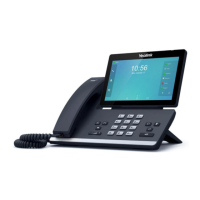Setting Up Your System
25
Specify the domain name that client should use
when resolving hostnames via DNS.
Specify the broadcast address in use on the
client's subnet.
Network Time
Protocol Servers
Specify a list of NTP servers available to the client
by IP address.
Vendor-Specific
Information
Identify the vendor-specific information.
Identify the vendor type.
Identify a TFTP server when the 'sname' field in
the DHCP header has been used for DHCP
options.
Identify a boot file when the 'file' field in the
DHCP header has been used for DHCP options.
For more information on DHCP options, refer to RFC 2131 or RFC 2132.
If you do not have the ability to configure the DHCP options for discovering the provisioning
server on the DHCP server, an alternate method of automatically discovering the provisioning
server address is required. Connecting to the secondary DHCP server that responds to DHCP
INFORM queries with a requested provisioning server address is one possibility. For more
information, refer to RFC 3925. If a single alternate DHCP server responds, this is functionally
equivalent to the scenario where the primary DHCP server responds with a valid provisioning
server address. If no DHCP servers respond, the INFORM query process will retry and eventually
time out.
DHCP Option 66 and Option 43
Yealink IP phones support obtaining the provisioning server address by detecting DHCP options
during startup.
The phone will automatically detect the option 66 and option 43 for obtaining the provisioning
server address. DHCP option 66 is used to identify the TFTP server. DHCP option 43 is a
vendor-specific option, which is used to transfer the vendor-specific information.
To use DHCP option 66 or DHCP option 43, make sure the DHCP Active feature is enabled.
Procedure
DHCP active can be configured using the following methods.

